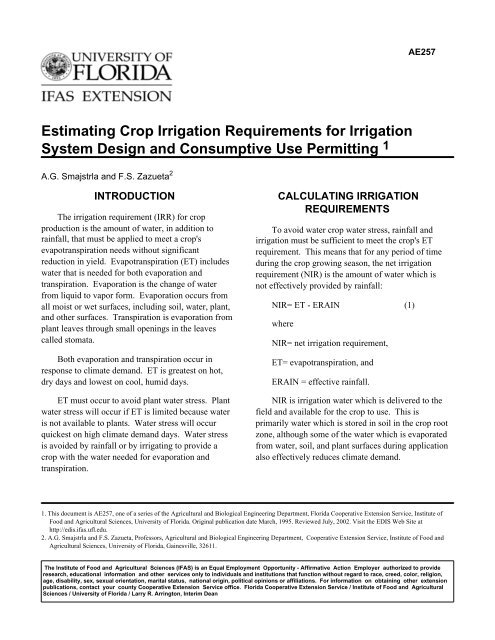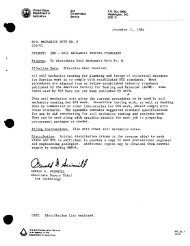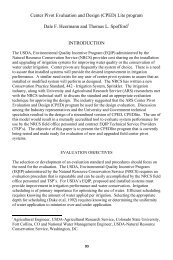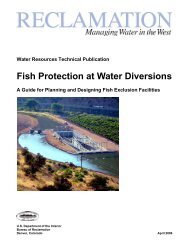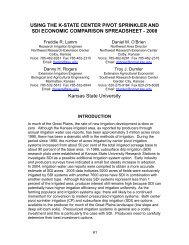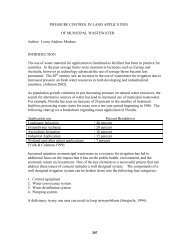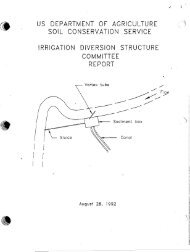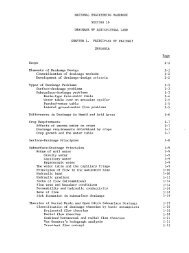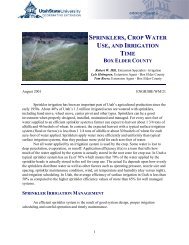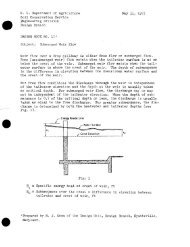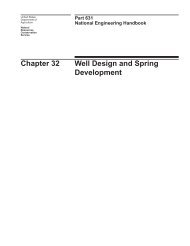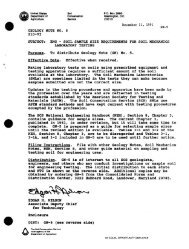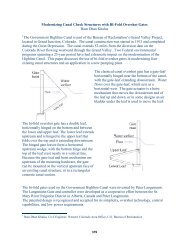Estimating Crop Irrigation Requirements for Irrigation System Design ...
Estimating Crop Irrigation Requirements for Irrigation System Design ...
Estimating Crop Irrigation Requirements for Irrigation System Design ...
Create successful ePaper yourself
Turn your PDF publications into a flip-book with our unique Google optimized e-Paper software.
AE257<br />
<strong>Estimating</strong> <strong>Crop</strong> <strong>Irrigation</strong> <strong>Requirements</strong> <strong>for</strong> <strong>Irrigation</strong><br />
<strong>System</strong> <strong>Design</strong> and Consumptive Use Permitting 1<br />
A.G. Smajstrla and F.S. Zazueta 2<br />
INTRODUCTION<br />
The irrigation requirement (IRR) <strong>for</strong> crop<br />
production is the amount of water, in addition to<br />
rainfall, that must be applied to meet a crop's<br />
evapotranspiration needs without significant<br />
reduction in yield. Evapotranspiration (ET) includes<br />
water that is needed <strong>for</strong> both evaporation and<br />
transpiration. Evaporation is the change of water<br />
from liquid to vapor <strong>for</strong>m. Evaporation occurs from<br />
all moist or wet surfaces, including soil, water, plant,<br />
and other surfaces. Transpiration is evaporation from<br />
plant leaves through small openings in the leaves<br />
called stomata.<br />
Both evaporation and transpiration occur in<br />
response to climate demand. ET is greatest on hot,<br />
dry days and lowest on cool, humid days.<br />
ET must occur to avoid plant water stress. Plant<br />
water stress will occur if ET is limited because water<br />
is not available to plants. Water stress will occur<br />
quickest on high climate demand days. Water stress<br />
is avoided by rainfall or by irrigating to provide a<br />
crop with the water needed <strong>for</strong> evaporation and<br />
transpiration.<br />
CALCULATING IRRIGATION<br />
REQUIREMENTS<br />
To avoid water crop water stress, rainfall and<br />
irrigation must be sufficient to meet the crop's ET<br />
requirement. This means that <strong>for</strong> any period of time<br />
during the crop growing season, the net irrigation<br />
requirement (NIR) is the amount of water which is<br />
not effectively provided by rainfall:<br />
NIR= ET - ERAIN (1)<br />
where<br />
NIR= net irrigation requirement,<br />
ET= evapotranspiration, and<br />
ERAIN = effective rainfall.<br />
NIR is irrigation water which is delivered to the<br />
field and available <strong>for</strong> the crop to use. This is<br />
primarily water which is stored in soil in the crop root<br />
zone, although some of the water which is evaporated<br />
from water, soil, and plant surfaces during application<br />
also effectively reduces climate demand.<br />
1. This document is AE257, one of a series of the Agricultural and Biological Engineering Department, Florida Cooperative Extension Service, Institute of<br />
Food and Agricultural Sciences, University of Florida. Original publication date March, 1995. Reviewed July, 2002. Visit the EDIS Web Site at<br />
http://edis.ifas.ufl.edu.<br />
2. A.G. Smajstrla and F.S. Zazueta, Professors, Agricultural and Biological Engineering Department, Cooperative Extension Service, Institute of Food and<br />
Agricultural Sciences, University of Florida, Gainesville, 32611.<br />
The Institute of Food and Agricultural Sciences (IFAS) is an Equal Employment Opportunity - Affirmative Action Employer authorized to provide<br />
research, educational in<strong>for</strong>mation and other services only to individuals and institutions that function without regard to race, creed, color, religion,<br />
age, disability, sex, sexual orientation, marital status, national origin, political opinions or affiliations. For in<strong>for</strong>mation on obtaining other extension<br />
publications, contact your county Cooperative Extension Service office. Florida Cooperative Extension Service / Institute of Food and Agricultural<br />
Sciences / University of Florida / Larry R. Arrington, Interim Dean
<strong>Estimating</strong> <strong>Crop</strong> <strong>Irrigation</strong> <strong>Requirements</strong> <strong>for</strong> <strong>Irrigation</strong> <strong>System</strong> <strong>Design</strong> and Consumptive Use.... 2<br />
Some water is lost while transporting it from its<br />
source to the crop root zone. Losses occur due to<br />
such causes as leakage from pipelines, seepage and<br />
evaporation from open channels, and evaporation<br />
from droplets sprayed through the air. Because of<br />
these losses, more water must be pumped than that<br />
required to be stored in the crop root zone. The gross<br />
irrigation requirement (IRR) is the amount that must<br />
be pumped. IRR is greater than NIR by a factor<br />
which depends on the irrigation efficiency (EFF):<br />
IRR = NIR / EFF(2)<br />
where<br />
IRR = gross irrigation requirement (inches),<br />
NIR = net irrigation requirement (inches), and<br />
EFF = irrigation efficiency (decimal fraction).<br />
ERAIN is that portion of rainfall which can be<br />
effectively used by a crop, that is, rain which is stored<br />
in the crop root zone. There<strong>for</strong>e, ERAIN is less than<br />
total rainfall due to interception, runoff and deep<br />
percolation (or drainage) losses.<br />
From the above definition, a crop's irrigation<br />
requirement does not include water applied <strong>for</strong><br />
leaching of salts, freeze protection, crop cooling, or<br />
other purposes, even though water <strong>for</strong> these purposes<br />
is required <strong>for</strong> crop production and is applied through<br />
an irrigation system. Total crop water requirements<br />
would be determined by adding water needed <strong>for</strong><br />
these uses to the irrigation requirement calculated<br />
from equation (1).<br />
From Equation (1), the irrigation requirement<br />
may be calculated <strong>for</strong> any time period; however, <strong>for</strong><br />
water (consumptive) use permitting purposes, it is<br />
normally calculated <strong>for</strong> monthly and seasonal or<br />
annual time periods.<br />
ESTIMATING IRRIGATION<br />
REQUIREMENTS<br />
Estimates of irrigation requirements can be made<br />
from 1) historical observations, or 2) numerical<br />
models. Numerical models may be based on<br />
statistical methods or on physical laws which govern<br />
crop water uptake and use.<br />
Historical Observations<br />
If a crop has been repeatedly grown at a given<br />
location, and if a long-term record has been kept of<br />
irrigation water applied, this record can be used to<br />
estimate future uses. Both long-term average as well<br />
as extreme values can be estimated using the<br />
historical record. The problem is that few such<br />
long-term data bases exist. It is desirable to have 20<br />
to 30 years of record to estimate extreme values with<br />
sufficient accuracy.<br />
Another problem with the use of the historical<br />
data method is that its use may be limited to the<br />
specific location where the data were obtained. The<br />
effects of differences in climate, soil, location, time<br />
of year during which the crop is grown, as well as<br />
other factors on irrigation requirements cannot be<br />
determined from the available data. Thus, although<br />
this method may be accurate <strong>for</strong> the continuous<br />
production of a given crop at one location, the data<br />
may not be useful <strong>for</strong> other crops at other locations.<br />
Historical data may be found in crop production<br />
guides or obtained from growers or irrigation system<br />
managers who have considerable field experience<br />
with a given crop and irrigation system.<br />
Numerical Models<br />
Numerical models may be based on statistical<br />
methods or on physical laws which govern crop water<br />
uptake and use. The Soil Conservation Service (SCS,<br />
1970) procedure is a statistical regression method.<br />
The Agricultural Field Scale <strong>Irrigation</strong> <strong>Requirements</strong><br />
Simulation (AFSIRS) model (Smajstrla, 1990) is a<br />
numerical simulation model based on the water<br />
budget of the crop root zone.<br />
Equation (1) may be applied by estimating<br />
monthly ET and ERAIN or by calculating daily water<br />
budgets and adding them <strong>for</strong> the required time<br />
periods. The first approach is used in the SCS<br />
method. The second was used in the AFSIRS model.<br />
There are advantages and limitations to both<br />
methods, as discussed in the following sections of<br />
this report.
<strong>Estimating</strong> <strong>Crop</strong> <strong>Irrigation</strong> <strong>Requirements</strong> <strong>for</strong> <strong>Irrigation</strong> <strong>System</strong> <strong>Design</strong> and Consumptive Use.... 3<br />
SCS Method<br />
The SCS method is a statistical regression<br />
method that allows monthly crop irrigation<br />
requirements to be estimated based on three factors:<br />
monthly crop ET, monthly rainfall, and soil<br />
water-holding characteristics, data that are readily<br />
available at most locations. The method is given in<br />
SCS Technical Release 21 (SCS, 1970). The model<br />
has the following characteristics:<br />
• It estimates irrigation requirements <strong>for</strong> monthly<br />
or longer time periods only. This is a limitation<br />
of the statistical regression approach used.<br />
• It estimates either mean or extreme values of<br />
irrigation requirements, based on rainfall drought<br />
frequency data used. To estimate mean values,<br />
long-term average values of monthly rainfall and<br />
ET are used in the regression model. To estimate<br />
extreme irrigation requirement values, extreme<br />
values of rainfall are used. A procedure is<br />
included to estimate extreme rainfall values from<br />
long-term average values <strong>for</strong> locations with<br />
widely-ranging rainfall characteristics.<br />
• It estimates irrigation requirements <strong>for</strong> crops<br />
grown on deep soils with no shallow water table<br />
present. This limits the application of this model<br />
to sprinkler and surface irrigation systems where<br />
the typical irrigation practice is to periodically<br />
irrigate the entire crop root zone to field capacity.<br />
It also limits the model application to deep soil<br />
types which freely drain excess rainfall. These<br />
were limitations of the data used to develop the<br />
regression model.<br />
• It estimates irrigation requirements <strong>for</strong> systems<br />
that irrigate the entire soil surface. This prohibits<br />
this model from being used with microirrigation<br />
systems because the effective rainfall model was<br />
developed assuming that the entire soil surface is<br />
irrigated.<br />
• It requires monthly rain and ET estimates or<br />
measurements. These may be either long-term<br />
values or specific monthly values, depending on<br />
whether the user is estimating long-term or<br />
specific monthly irrigation requirements.<br />
• It requires soil water storage data. Soil water<br />
storage data are input to the model as the typical<br />
depth of water applied per irrigation. It is<br />
assumed that the depth of water applied is<br />
appropriate <strong>for</strong> the soil water-holding<br />
characteristics and the crop water requirements.<br />
AFSIRS Model<br />
The AFSIRS model is a water budget model that<br />
was developed by the authors of this publication.<br />
AFSIRS is an acronym <strong>for</strong> Agricultural Field Scale<br />
Numerical Simulation Model. It is a computer<br />
simulation model based on a daily water budget of the<br />
crop root zone. The AFSIRS model has the following<br />
characteristics:<br />
• It estimates irrigation requirements <strong>for</strong> daily,<br />
weekly, two-week, monthly, seasonal, and<br />
annual time periods. Because it is based on daily<br />
water budgets, irrigation requirements can be<br />
calculated <strong>for</strong> shorter periods of time than with<br />
the SCS model. However, estimates <strong>for</strong> very<br />
short (daily) time periods are often not very<br />
meaningful because these data are highly<br />
variable.<br />
• It requires long-term historical climate data<br />
bases of daily ET and rain to calculate daily<br />
water budgets of the crop root zone. These<br />
calculations require a long-term climate record of<br />
daily reference ET and rainfall <strong>for</strong> the location<br />
being studied. Ideally, 20 to 30 years of climate<br />
record should be used in order to be able to<br />
accurately estimate extreme values of irrigation<br />
requirements.<br />
• It estimates both mean and extreme values of<br />
irrigation requirements, based on probabilities<br />
calculated from daily irrigation requirements<br />
simulated. The year-to-year distributions are<br />
used to calculate extreme values by fitting a<br />
theoretical function to the actual annual data. A<br />
coefficient is calculated which indicates how<br />
well the data fit the theoretical distribution so the<br />
user can determine whether the data base is<br />
sufficiently long to accurately estimate the<br />
desired extreme values.
<strong>Estimating</strong> <strong>Crop</strong> <strong>Irrigation</strong> <strong>Requirements</strong> <strong>for</strong> <strong>Irrigation</strong> <strong>System</strong> <strong>Design</strong> and Consumptive Use.... 4<br />
• It estimates irrigation requirements <strong>for</strong> common<br />
Florida irrigation systems, including sprinkler,<br />
surface, micro and seepage systems. All four<br />
types of systems are included in the model by<br />
simulating the effects of periodic irrigations of<br />
the entire soil surface with sprinkler and surface<br />
irrigation systems, high water tables in seepage<br />
irrigation systems, and partial root zone<br />
irrigation in microirrigation systems.<br />
• It requires many inputs which describe crop,<br />
soil, irrigation system, and management factors<br />
which affect irrigation requirements. The user is<br />
prompted <strong>for</strong> each of these inputs; however,<br />
default values are given <strong>for</strong> each input, based on<br />
typical Florida conditions.<br />
• It is limited by few available data <strong>for</strong> some<br />
Florida crops and production systems. Because<br />
of the great diversity of Florida's agriculture, not<br />
all crops and production systems have been<br />
extensively studied. However, the AFSIRS<br />
model contains actual crop data when available<br />
and the author's best estimates <strong>for</strong> coefficients<br />
and data that can be extrapolated from other<br />
locations. In all cases, the user can change the<br />
model input data as required to customize the<br />
model <strong>for</strong> a specific application or based on the<br />
most recent research results.<br />
SUMMARY AND CONCLUSIONS<br />
Numerical models may be based on statistical<br />
methods or on physical laws which govern crop water<br />
uptake and use. Two models are available <strong>for</strong> use in<br />
Florida: the SCS statistical regression model and the<br />
AFSIRS water budget model. The use of the SCS<br />
model is limited to monthly or seasonal calculations<br />
of irrigation requirements of surface or sprinkler<br />
irrigated crops on deep, well-drained soils.<br />
The AFSIRS model is more flexible: it can be<br />
used <strong>for</strong> all Florida soils and irrigation systems.<br />
However, because it requires much more input data<br />
than the SCS model, the data required <strong>for</strong> all crops<br />
and production systems may not be readily available.<br />
REFERENCES<br />
SCS. 1970. <strong>Irrigation</strong> Water <strong>Requirements</strong>.<br />
Technical Release No. 21. USDA Soil<br />
Conservation Service. Washington, DC.<br />
Smajstrla, A.G. 1990. Technical Manual,<br />
Agricultural<br />
Field Scale <strong>Irrigation</strong> <strong>Requirements</strong> Simulation<br />
(AFSIRS) Model. Version 5.5. Ag. Eng. Dept.<br />
Univ. of Florida, Gainesville.<br />
The irrigation requirement (IRR) <strong>for</strong> crop<br />
production is the amount of water, in addition to<br />
rainfall, that must be applied to meet a crop's<br />
evapotranspiration needs without significant<br />
reduction in yield. Estimates of irrigation<br />
requirements can be made from 1) long-term<br />
historical observations, or 2) numerical models.<br />
Few long-term historical data bases exist. Also,<br />
these data bases may not be readily extrapolated to<br />
other sites, thus they may have limited use <strong>for</strong><br />
estimating irrigation requirements <strong>for</strong> irrigation<br />
system design or consumptive use permitting<br />
purposes. For these reasons, numerical models have<br />
been developed and are used to estimate irrigation<br />
requirements <strong>for</strong> a wide range of crop and production<br />
conditions.


